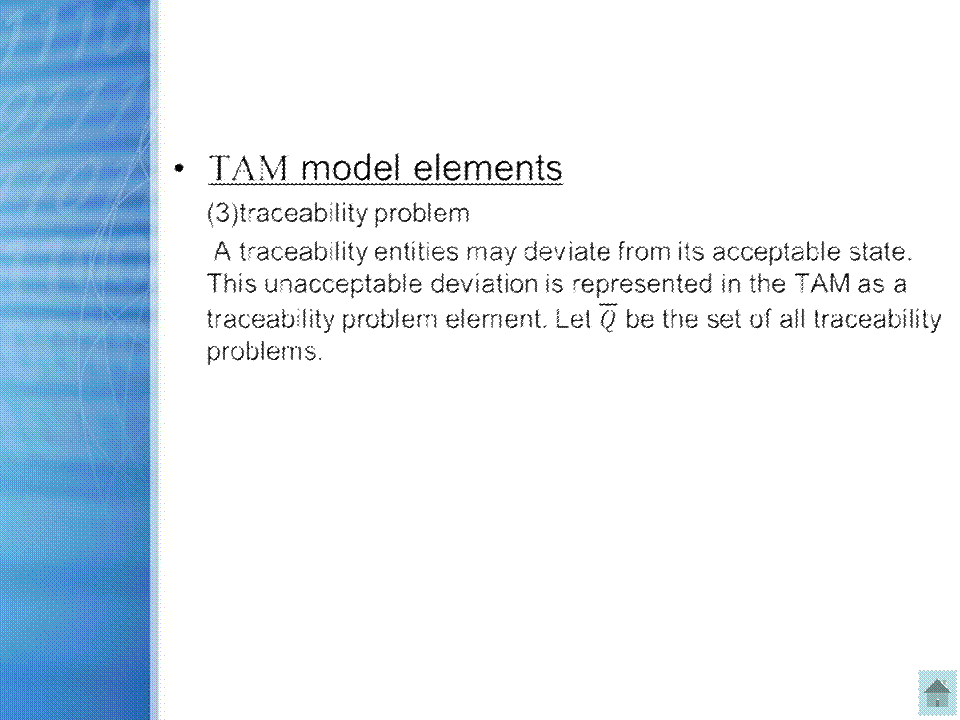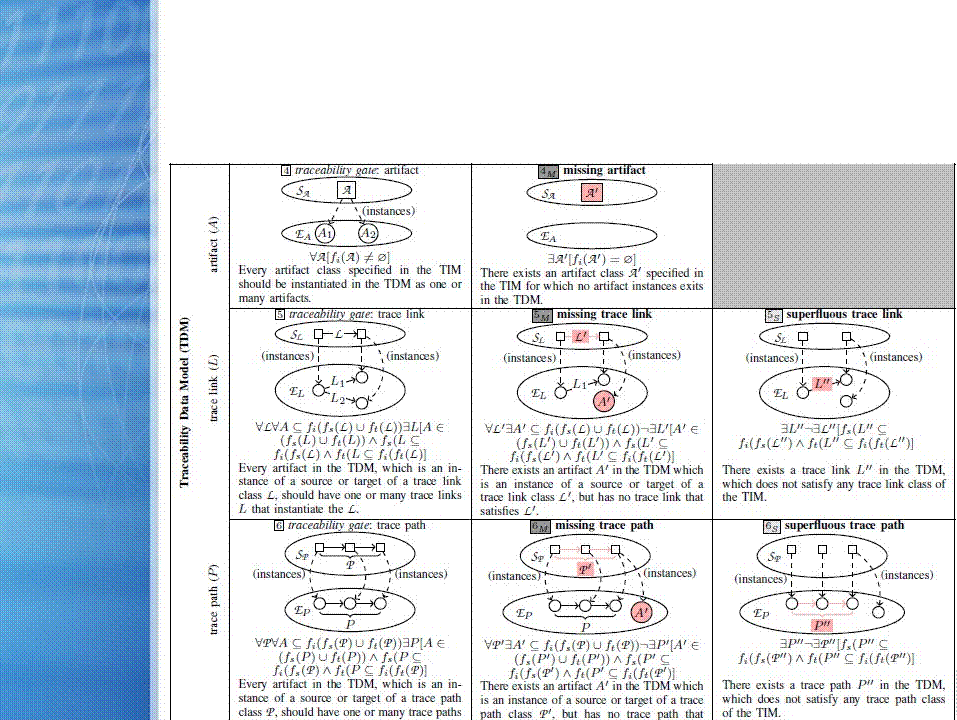Contents
• Background
• The goal of this study
• Related concepts
• Methods and processes
• Survey
• Conclusion
• Limitations
• Future work
Background
• In practice, traceability is created and maintained by humans, which make mistakes. In result, existing traces are potentially of dubious quality but serve as the foundation for high impact development decisions.
• the experts weight the occurrence of different traceability problems with different criticality. This information can be used to quantify the impact of traceability problems and to prioritize the assessment of traceability
|
The goal of this study
Derive a quality model that specifies per element the acceptable state (Traceability Gate) and unacceptable deviations (Traceability Problem) from this state. We describe and formally define how both, the acceptable states and the unacceptable deviations can be detected in order to enable practitioners to systematically assess their project’s traceability.
|
| ||
Related concepts
Requirements traceability
defined as the “ability to describe and follow the life of a requirement in both forwards and backwards direction”
|
Related concepts
Traceability Information Model (TIM)
(1) artifact class
An artifact class specifies classes of artifacts for which traceability is required within the software development project, denoted as .
(2) trace link class
A trace link class specifies classes of trace links between two artifact
![]() classes. denoted as
classes. denoted as ![]() . The function fs : ® maps each trace link class
. The function fs : ® maps each trace link class
to its source artifact class. The function
class to its target artifact class.
(3) trace path class
ft : ®
maps each trace link
Specifies a sequence of trace link classes between two artifact
![]() classes denoted as . The function
classes denoted as . The function
fs :
maps each trace path
![]()
![]() class to its source artifact class. The function
class to its source artifact class. The function
trace path class to its target artifact class.
ft :
maps each
Related concepts
Traceability Information Model (TIM)
|
|
Related concepts
Traceability Data Model (TDM)
In order to use traceability, it is required to establish trace links as specified in the TIM usually by means of an explicit registration of the artifacts and their links in a traceability repository. Traceability Data Model (TDM) to refer to all traceability data that is created, maintained, and used throughout a developpment lifecycle.
|
|
Related concepts
Traceability Roles
|
(1) traceability stakeholder
we refer to the role that is demanding traceability between
![]() artifact classes as traceability stakeholder. Let O bet the set of
artifact classes as traceability stakeholder. Let O bet the set of
![]() all mandated artifact classes,O be the set of all mandated trace
all mandated artifact classes,O be the set of all mandated trace
![]() link classes, andO be the set of all mandated trace path
link classes, andO be the set of all mandated trace path
classes, which are mandated by the role traceability takeholder.
|
Related concepts
Traceability Roles
(2) traceability planner
We denote traceability information that is specified by the role
traceability planner as specified elements of traceability planning.
(3) traceability creator
We refer to the role that is concerned with establishing traceability data as the traceability creator.
|
|
Methods and processes
Methods and processes
• Traceability Assessment Model (TAM)
Practitioners participating in our empirical studies reported that they miss clear guidance on how to systematically assess their implemented traceability. To address this problem, we propose a Traceability Assessment Model (TAM) for analyzing the suitability of established traceability with respect to its intended purpose. Since different kinds of traceability problems can exist per traceability gate, we assign a problem category to each traceability problem.
 This problem categorization is supposed to improve the model comprehensiveness and can also support practitioners with clustering traceability problems.
This problem categorization is supposed to improve the model comprehensiveness and can also support practitioners with clustering traceability problems.
|
Methods and processes
• TAM model elements
(1) traceability entities
![]() In particular, the fundamental traceability elements are artifact classes, trace link classes, trace path classes, artifacts,trace links, and trace paths (see Section II). Let E be the set of all traceability entities, where
In particular, the fundamental traceability elements are artifact classes, trace link classes, trace path classes, artifacts,trace links, and trace paths (see Section II). Let E be the set of all traceability entities, where
(2) traceability gates
specifies the acceptable state of a traceability entity in terms of quality.
![]() Q be the set of all defined traceability gates
Q be the set of all defined traceability gates
C be the set of all defined criteria.
|
 Methods and processes
Methods and processes
Assessment processes
Criterion
Gate
acceptable state
Problem category
missing Superfluous
problems
1. Missing traceability information
Criterion
Problem impact
2. Missing traceability data
3. Superfluous traceability informatio 4.Superfluous traceability data
Methods and processes
• Assessment processes
(1) Two aspects of the assessment
First, the traceability information, which is specified by the traceability planner, does not conform with the mandated traceability. Second, the traceability data, which is established by the traceability creator, does not conform with the specified traceability information.
|
 Solution and processes
Solution and processes
• Assessment processes
(2) acceptable state
|
|
Solution and processes
• Assessment processes
(2) problem category
First, the fulfilling set is incomplete, because it misses data in order to fully conform with the set of required data. This state is represented in our quality model by the problem category missing traceability. Second, the fulfilling set is redundant, because it contains superfluous data, not necessary to conform with the set of required data. This state is represented in our quality model by the problem category superfluous traceability. Third, the fulfilling set is incomplete and redundant, and thus a composite problem categories of missing traceability and superfluous traceability.
|
Solution and processes
•  Assessment processes
Assessment processes
|
 Solution and processes
Solution and processes
• Assessment processes
Solution and processes
• Assessment processes
(3) problem impact
 ① Missing
① Missing
• 1M implies 2M, because an artifact class is an integral component of a trace link class. the problem
• 1M only indicates potentially 3M , because an artifact class is an integral component of a trace path class as well, but for one specific artifact class a trace path class might not be required.
• 3M implies 2M , because an trace link class is an integral component of a trace path class.
• 1M also implies 4M ,Since each artifact is an instance of artifact class.
|
Solution and processes
• Assessment processes
(3) problem impact
② Superfluous
|
Similar to missing cases,There are two differences, first, 1s only indicates potentially 3s, because theoretically an artifact class could be specified without participating in any trace link class. second, does not contain a case for superfluous artifacts ,because an artifact is an instance of
an artifact classifier and by definition cannot exist without it.
|
Survey
Survey
|
|
|
Survey
|
Figure 10 summarizes the subjects’ ratings per traceability entity. The horizontal alignment of a bubble represents the relevance of the associated traceability gate. The vertical alignment of a bubble represents the criticality of the associated traceability problem. Thereby, traceability problems of the problem category missing are shown in dark-gray and traceability problems of the problem category missing are shown in light-gray. The radius of each bubble represents the inverse standard deviation among the subjects’ criticality ratings. That means the bigger the circle the higher the subjects’ consensus.
|
Conclusion
Conclusion
(1) the proposed model provides clear guidance on how to systematically assesseach traceability
element in a software project for potential structural
traceability problems.
(2) the proposed TAM specifies unambiguous assessment criteria. Second, the resultsof our expert survey provide weights that quantify the criticality,and thus the potential impact of the traceability problems
Limitations
Limitations
First, our model cannot be used to identify semantically incorrect trace links between artifacts. For this purpose, a semantic analysis of the trace links and artifacts would be required, which is out of the scope of this work. Second, our model can only be used to identify incomplete or redundant traceability data. It cannot be used to identify whether or not the existing traceability in a project is semantically complete. Similarly, a semantic analysis would be required for this kind of assessment.
|
Future Work
Future work
(1) Based on the proposed quality model, we want to provide tool support to automate the assessment of traceability.
(2) Future work could also focus on the semantic correctness and completeness of trace links to further support practitioner with traceability assessment.
Information retrieval approaches or heuristics could be used to automate the semantic analysis of traceability, which today are mainly used for automated
|































